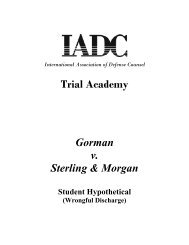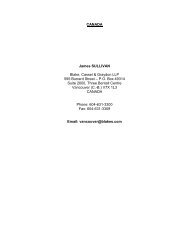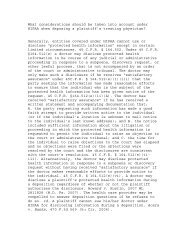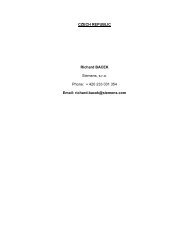Defense Counsel Journal - International Association of Defense ...
Defense Counsel Journal - International Association of Defense ...
Defense Counsel Journal - International Association of Defense ...
Create successful ePaper yourself
Turn your PDF publications into a flip-book with our unique Google optimized e-Paper software.
Page 470 DEFENSE COUNSEL JOURNAL–October 2012Although we have used the termfortuity in the past, we have notfully explored its breadth andscope. In short, fortuity consists<strong>of</strong> two central aspects: intent,which we have discussed inearlier opinions, and control,which we have not previouslydiscussed. 10Obviously, intent is relevant indetermining fortuity. That which isintended is, by definition, not accidental.The applicability <strong>of</strong> the second concept,control, is less obvious but equallycompelling. A general liability policy isnot intended to provide coverage forthose risks which are within the insured’scontrol, such as the selection <strong>of</strong>competent subcontractors and thefurnishing <strong>of</strong> quality building materialsproperly installed to provide protectionfrom the elements. Since the quality <strong>of</strong>construction is always within the control<strong>of</strong> the contractor, whether the work isperformed by a subcontractor or thecontractor’s own employees, any losswhich results from poor workmanshipcannot possibly be considered fortuitous.No fortuity, no accident, no occurrence,no coverage.In Hawkeye-Security Insurance v.Davis, the Missouri Court <strong>of</strong> Appealsfollowed this rationale in concluding thata claim against a builder for building adefective home was not covered eventhough much <strong>of</strong> the work was performedby subcontractors. 11 The court simplyheld that the construction was entirely10Motorists Mutual, 306 S.W.3d at 74(internal footnote omitted).11 See Hawkeye-Security Ins. Co. v. Davis, 6S.W.3d 419 (Mo. Ct. App. 1999).within the insured’s control and thereforeany damage resulting therefrom could notbe fortuitous. The Court also chose torest its decision on the distinctionbetween tort and contract theories:These uncontroverted factsestablish that Appellants’losses stem solely fromDavis’s breach <strong>of</strong> hiscontractual obligations,breach <strong>of</strong> his expresswarranties, or breach <strong>of</strong>implied warranties inconnection with thisconstruction. However,“breach <strong>of</strong> a definedcontractual duty cannot fallwithin the term ‘accident.’”[American Stats Ins. Co. v.]Mathis, 974 S.W.2d 647, 650[(Mo. Ct. App. 1998)]. Asthe Mathis court explained:“Performance <strong>of</strong> [the]contract according to theterms specified therein waswithin [the insuredcontractor’s] control andmanagement and its failure toperform cannot be describedas an undesigned orunexpected event.” 12B. Defective Construction,Standing Alone, is not an“Occurrence”The next position on the spectrum iswell illustrated by the decision <strong>of</strong> theNebraska Supreme Court in Auto-OwnersInsurance Company v. Home Pride12 Id.












